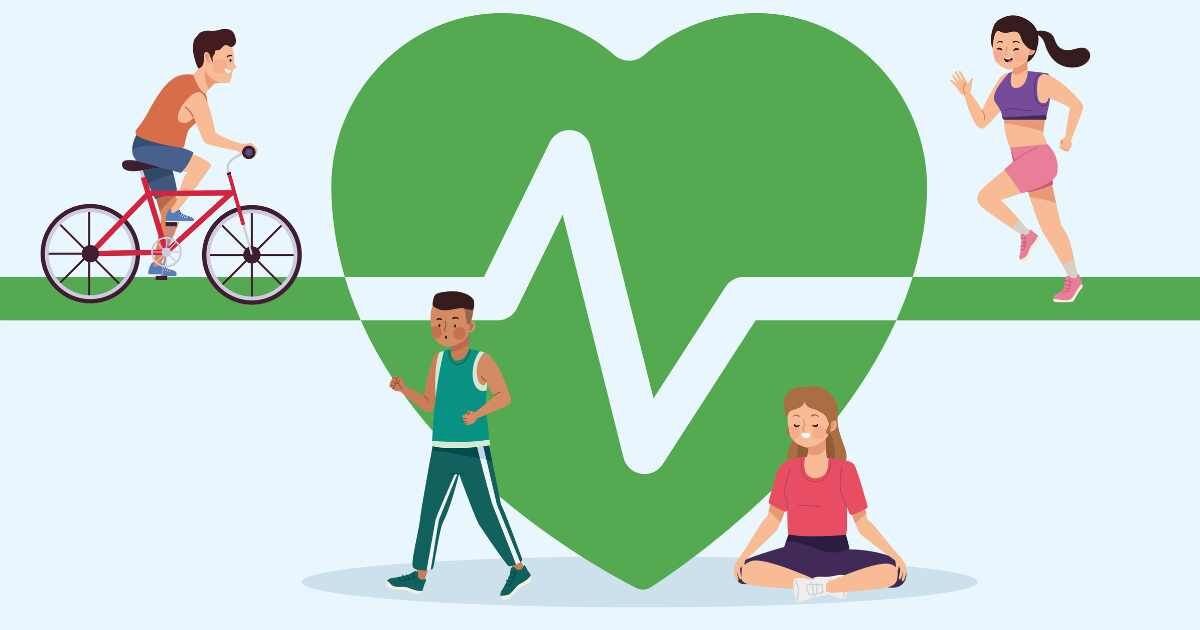Blog
Cardio Tips for a Healthier Heart this New Year

Everyone wants to be healthier, especially as the new year rolls around. New year, new resolution, new cardio goals. In this blog post, we’ll explore cardio tips to improve your heart health this new year.
Step 1: Get Evaluated
The most crucial step before starting any health journey is making sure you’re getting properly evaluated. According to the Government of Canada, heart disease is the second leading cause of death in the country. It can sometimes go undetected if you aren’t looking for it.
So, the best course of action before anything else is to check in with your healthcare provider and do the necessary course of testing and physical check-up to make sure your health is in order.
Here are some examples of basic and more detailed testing:
Basic Evaluations
1. Medical History and Physical Examination
Discussion of symptoms like chest pain, shortness of breath, or fatigue.
Assessment of risk factors such as smoking, diet, diabetes, and lifestyle.
Checking heart rate and blood pressure and listening to heart sounds with a stethoscope.
2. Blood Tests
Lipid Panel: Measures cholesterol levels (HDL, LDL, triglycerides).
C-Reactive Protein (CRP): Detects inflammation that may indicate cardiovascular risk.
Blood Sugar: Assesses for diabetes, a risk factor for heart disease.
Non-Invasive Tests
1. Electrocardiogram (ECG or EKG)
Records the electrical activity of the heart.
Detects arrhythmias, heart attacks, and other abnormalities.
2. Echocardiogram
An ultrasound of the heart to visualize structure and function.
Assesses heart valves, chambers, and pumping efficiency.
3. Stress Test
Monitors the heart’s performance under physical stress, often using a treadmill or stationary bike.
Identifies problems with blood flow to the heart.
4. Holter Monitor or Event Recorder
Portable devices worn for 24-48 hours (Holter) or longer (Event Recorder).
Detects intermittent arrhythmias or symptoms like palpitations.
5. Ankle-Brachial Index (ABI)
Compares blood pressure in the arms and legs.
Screens for peripheral artery disease (PAD).
Step Two: Move More
While this might seem like an obvious step, many Canadians don’t get adequate exercise. On average, 45 per cent of Canadian adults meet the recommended 150 minutes per week of moderate-to-vigorous physical activity to keep the heart healthy. Moderate physical activity is defined as an activity which causes you to sweat, increasing your resting heart rate by approximately 50%, and is performed for approximately 30 minutes, with necessary breaks.
However, a lot of Canadian adults struggle to get enough exercise due to their busy lifestyles. In an age where a lot of people work from home, it can be a challenge to get enough exercise. It's hard enough to motivate yourself for a walk in the freezing Canadian winter, but when darkness falls early, it feels almost impossible.

Luckily, there are plenty of ways you can get creative to make sure you’re getting some good cardio exercise.
Under-desk walking pad: effectively a mini treadmill, an under-desk walking pad can help you get those steps in while you work. Whether you want to crunch some emails while going for a brisk walk or spend your lunch doing steps, this is a great option for adults who need to get more exercise.
At-home workouts: YouTube and other streaming services have plenty of easy at-home workouts with varying difficulty levels to help you keep in shape.
Take the stairs: Live up high? Work up high? Take the stairs. Taking the stairs burns up to 530 to 835 calories per hour. One hour of going up the stairs might not seem feasible, but spaced out throughout your work weeks might be more digestible.
Take the dog for a walk: We know it’s cold, but going out during peak afternoon hours and getting a brisk walk with the dog is a good way to keep the owner and pet happy and healthy.
Go for a swim: Indoor swimming pools are an excellent option during the winter if you need some great exercise with a lower impact. Swimming is easier on the joints and is a good option for those with physical limitations.
Take breaks from the computer: If you get a lot of screen time, it could be good to just take a break and do a little pacing throughout the day to get your steps up. Setting a timer is a great reminder to take breaks!
Do some hula-hooping: If you have limited space, hula-hooping is a great way to get some great cardio. Besides, it’s also very fun and accessible.
Walking in place: walking videos and walking in place is easy and can be done indoors where things are warm.
Cycling: Exercise bikes offer a great opportunity to get moderate to intense cardio exercise throughout the week. They’re also relatively beginner-friendly.
Do some jumping jacks: Probably one of the easiest workouts to do at home, jumping jacks are perfect if you need to get in some quick cardio.
Step Three: Adjust Your Diet
Holiday food is the best, isn’t it? Of course, it is, and it’s absolutely OK to indulge a little. However, in the new year, to keep your cardiovascular health in the green, you need to add a little more to your diet. You can refer to Canada’s Food Guide.
Cut Out Fat & Salt
Avoid saturated fats and highly processed, salt-laden foods. You can enjoy each in moderation, but if you regularly go for fast food or convenience foods, now is the time to cut back. Also, use more herbs and salt-free spices in your regular cooking instead of always reaching for the saltshaker, and opt for oils like avocado and olive instead of vegetable.
Increase Your Fruit and Veggie Intake
A diet rich in fruits and vegetables is essential for keeping your heart healthy. Here’s a list of some of the best fruits and veggies to eat in a heart-healthy diet.

Heart-Healthy Fruits
Berries (Blueberries, Strawberries, Raspberries, Blackberries)
Apples
Citrus Fruits (Oranges, Grapefruits, Lemons)
Avocados
Bananas
Cherries
Pomegranates
Kiwi
Papaya
Grapes
Heart-Healthy Vegetables
- Leafy Greens (Spinach, Kale, Swiss Chard) *Consult your pharmacist if you are on an anti-coagulant treatment
- Broccoli
- Carrots
- Tomatoes
- Bell Peppers
- Beets
- Brussels Sprouts
- Sweet Potatoes
- Garlic
- Cauliflower
Choose Low-Fat Proteins
Whether you eat meat or not, choosing low-fat proteins is excellent for not only keeping you full but keeping your heart happy. Here’s a list of some of the most heart-healthy, low-fat proteins:
Heart-Healthy, Low-Fat Protein Sources
Skinless chicken breast
Turkey breast
Egg whites or egg substitutes
Fish (Salmon, Tuna, Cod, Tilapia)
Shellfish (Shrimp, Scallops, Crab)
Tofu
Tempeh
Lentils
Chickpeas
Black beans
Kidney beans
Edamame
Low-fat cottage cheese
Greek yogurt (non-fat or low-fat)
Quinoa
Seitan
Peas
Whey protein isolate (low-fat)
Almonds and walnuts (in moderation)
Limit Alcohol
It’s OK to have an occasional drink, especially something like a dry red wine that’s low in sugar. However, this needs to be an occasional occurrence rather than a regular one. If you’re finding you’re having a hard time cutting back, see the Canadian Centre on Substance Use and Addiction.
In the meantime, here are some alternatives to alcoholic drinks:
Non-Alcoholic Drink Alternatives
Sparkling water with fruit slices (e.g., lemon, lime, or berries)
Mocktails (e.g., virgin mojito, non-alcoholic piña colada)
Kombucha
Herbal teas (hot or iced)
Non-alcoholic beer or wine
Soda water with bitters
Freshly pressed juices (e.g., orange, apple, or carrot)
Coconut water
Flavored sparkling water
Iced coffee or tea
Eat Whole Grains
We get that it’s very trendy to do a low-carb diet, but whole grains can be a great part of a healthy diet. They keep you full and energized and are generally very healthy food options. Here’s a list of some of the healthiest grains to add to your diet:
Healthiest Whole Grains
Quinoa
Brown rice
Oats
Barley
Farro
Bulgur
Millet
Buckwheat
Freekeh
Spelt
Teff
Whole wheat (e.g., whole wheat bread, pasta, or flour)
Wild rice
Amaranth
Rye
When to Talk to a Professional
If you notice you’re beginning to struggle with shortness of breath, chest pains, have experienced sudden weight gain or elevated blood pressure, it’s time to talk to a professional. We advise that any health journey begins with an evaluation – but you need to have regular check-ups with your healthcare provider every year to make sure you’re in tip-top shape. Even if you’re not experiencing obvious symptoms, regular check-ups are recommended.
Also, you could benefit from meeting with a dietician if you’re struggling to stick to a healthy eating plan. Education is the best medicine when preventing illness.
Choose Cook’s Pharmacy
At Cook’s Pharmacy, we know you by name and we understand your health history and concerns. We work alongside you to make sure your health and well-being are a top priority.
Unlike other chain pharmacies, Cook’s Pharmacy is your friendly neighbourhood pharmaceutical providers who invest in your well-being. We want to make sure you’re not only healthy, but all of your concerns are addressed with every single visit. We aim to educate and empower all of our patients to take control of their health.
With Cook’s Pharmacy, this isn’t about the bottom line. It’s all about ensuring you’re well taken care of. And here, we’ll provide you with all of the care you need. Our philosophy is to keep patient care patient-centric.
Contributors
Latest Posts
Show All Recent Posts
Archive
-
2025
-
July
-
June
-
May
-
April
-
March
-
February
-
January
-
-
2024
-
December
-
November
-
October
-
September
-
August
-
July
-
June
-
May
-
April
-
March
-
February
-
January
-
-
2023
-
December
-
November
-
October
-
September
-
August
-
May
-
April
-
March
-
February
-
January
-
-
2022
-
December
-
November
-
October
-
September
-
August
-
July
-
June
-
May
-
April
-
February
-
